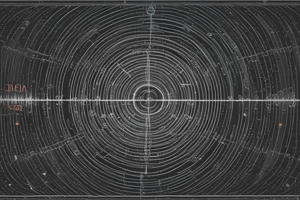Podcast
Questions and Answers
What is the result of multiplying 46 by 7 when using the order of operations, including brackets, to work out simple calculations?
What is the result of multiplying 46 by 7 when using the order of operations, including brackets, to work out simple calculations?
322
What is the decimal equivalent of the fraction 3/4?
What is the decimal equivalent of the fraction 3/4?
0.75
How can you determine if a number is divisible by 6?
How can you determine if a number is divisible by 6?
A number is divisible by 6 if it is divisible by both 2 and 3.
What is the result of subtracting 4.2 from 7.8?
What is the result of subtracting 4.2 from 7.8?
What is the equivalent mixed number for the improper fraction 7/3?
What is the equivalent mixed number for the improper fraction 7/3?
How would you order the following numbers on a number line: -5, -2, 0, 1 and 4?
How would you order the following numbers on a number line: -5, -2, 0, 1 and 4?
Explain how Eratosthenes' 'sieve' method can be used to generate primes less than 100.
Explain how Eratosthenes' 'sieve' method can be used to generate primes less than 100.
What is the relationship between a ratio and a proportion, and how can it be used to solve problems?
What is the relationship between a ratio and a proportion, and how can it be used to solve problems?
How can you simplify a ratio, and what are the benefits of doing so?
How can you simplify a ratio, and what are the benefits of doing so?
What is the distinction between rounding up and rounding down in division, and when is each approach appropriate?
What is the distinction between rounding up and rounding down in division, and when is each approach appropriate?
How can you convert a fraction to a decimal, and what are the benefits of doing so?
How can you convert a fraction to a decimal, and what are the benefits of doing so?
What is the difference between a simple fraction and a percentage, and how can they be used to describe different quantities?
What is the difference between a simple fraction and a percentage, and how can they be used to describe different quantities?
Flashcards are hidden until you start studying
Study Notes
Number Facts and Operations
- Recall positive integer complements to 100
- Recall multiplication facts to 10 × 10 and associated division facts
- Use the order of operations, including brackets, to work out simple calculations
Decimals and Place Value
- Interpret decimal notation and place value
- Multiply and divide whole numbers and decimals by 10, 100, or 1000
- Order decimals, including measurements, and change them to the same units
- Round whole numbers to the nearest 10, 100, or 1000, and decimals to the nearest whole number or one decimal place
Multiplication and Division
- Use known facts and place value to multiply and divide two-digit numbers by a single-digit number
- Multiply simple decimals by one-digit numbers
- Divide whole numbers and decimals by 10, 100, or 1000
Fractions, Decimals, and Percentages
- Recognize the equivalence of simple fractions, decimals, and percentages
- Simplify fractions by cancelling common factors
- Identify equivalent fractions, and convert terminating decimals to fractions
- Compare two fractions by using diagrams or converting to decimals
Negative Numbers and Integers
- Recognize negative numbers as positions on a number line
- Order, add, and subtract positive and negative numbers in context
Factors, Multiples, and Primes
- Recognize multiples, factors, common factors, and primes (all less than 100)
- Use simple tests of divisibility
- Find the lowest common multiple in simple cases
- Use the 'sieve' method for generating primes developed by Eratosthenes
Squares and Square Roots
- Recognize squares of whole numbers to at least 20 × 20 and the corresponding square roots
- Use the notation √ and ²
Addition and Subtraction of Fractions
- Add and subtract two simple fractions
- Find fractions of quantities (whole number answers)
- Multiply a fraction by an integer
Percentages
- Understand percentage as the number of parts in every 100
- Use fractions and percentages to describe parts of shapes, quantities, and measures
- Calculate simple fractions and percentages of quantities
Studying That Suits You
Use AI to generate personalized quizzes and flashcards to suit your learning preferences.




